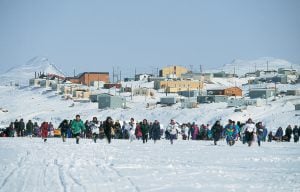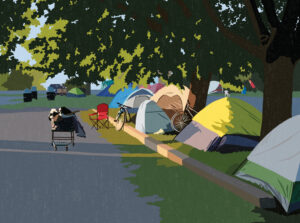
History
Throwback Thursday: Nunavut up and running
On April 1, 1999, Canada’s youngest population took control of its largest territory. Here’s how Canadian Geographic covered the story.
- 2880 words
- 12 minutes
This article is over 5 years old and may contain outdated information.
People & Culture

Adventurers Erik Boomer, Kate Breen and siblings Eric and Sarah McNair-Landry set out earlier this summer on an expedition they call Qajaqtuqtut, an Inuit word meaning, “they kayak.” The team spent months building traditional Inuit sea kayaks in an effort to contribute to the revival of the 4,000-year-old kayak-building tradition in Canada’s North.
After building the kayaks, the team left Qikiqtarjuaq, Nunavut, and crossed the Penny Ice Cap, Baffin Island’s largest. Deep, soft snow covered the crevasses on the ice cap, making them difficult to spot.


“Our rescue system was tested when Kate slipped chest deep into a crevasse,” Boomer wrote on the team’s blog. “Eric and I both arrested and held the line taut, and before long Kate was back on solid ice.”
Some of the worst challenges are much, much smaller: mosquitoes.
“Numerous people who have travelled in these areas told us that the mosquitoes would be terrible,” Breed wrote. “One person told us that they have been known to kill dogs . . . and even people. While we’ve not felt that our lives are in peril, the inside of my tent does look like the scene of a violent crime; blood streaks, dead mosquitoes stuck to the roof, to the walls and on the floor. The bugs get into everything: breakfast, dinner, the inside of your bug jacket, the inside of your sunglasses and the inside of your pants.”

The expedition, funded by the Royal Canadian Geographical Society, is testing the team members both physically and emotionally.
“This trip has been stressful in a whole new way. Long days, mosquito bites, sore hands and bruises from innumerable falls. Sometimes I cry.” Breen wrote. “The Amadjuak, a raging high-volume torrent of a river whose large rapids and strong currents stalled our progress for days on end, it made me cry. The weather has taken a turn for the worst; rain, headwinds, sleet and snow. Our gear is saturated. But for one change of clothes, one pair of socks, everything that I have is soaked. Mornings are cold and I summon every ounce of toughness to wiggle into my wet clothes.”
Read more about this expedition or learn about The Royal Canadian Geographical Society’s expeditions program.
Are you passionate about Canadian geography?
You can support Canadian Geographic in 3 ways:

History
On April 1, 1999, Canada’s youngest population took control of its largest territory. Here’s how Canadian Geographic covered the story.

People & Culture
The story of how a critically endangered Indigenous language can be saved

People & Culture
The death of an unhoused Innu man inspired an innovative and compassionate street outreach during the nightly curfew in 2021

People & Culture
For unhoused residents and those who help them, the pandemic was another wave in a rising tide of challenges